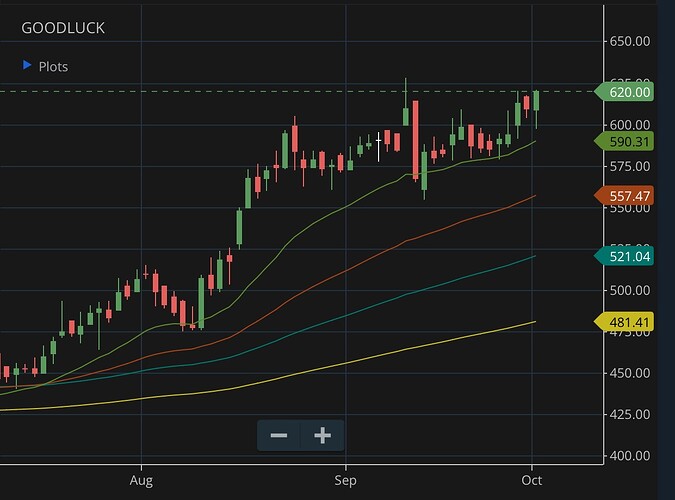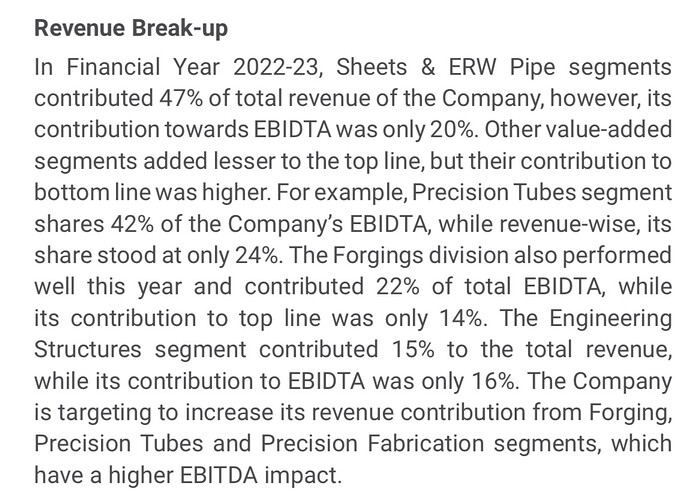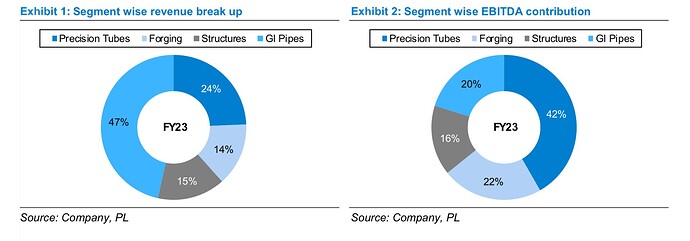Yes, completely agree with your POV. Only point I am trying to make is how many of us withstand 50% drawdown for a period of 1-2 years is the question if you are totally in smallcap funds
Posts tagged Value Pickr
Barbeque nation Ltd (05-10-2023)
Just my thought – Infact closing of restaurant is not bad when they are adding more at profitable locations. I observed that patterns in all players in similar businesses. Also, almost every retail business is doing that. For me one of the worrying point was an ace investors exit . Anyways , very small position at this stage .
Discloser – hold ( 2% of my portfolio ).
Dr Agarwal’s Eye Hospital Ltd (DAEHL) (05-10-2023)
Thanks for sharing. Looks promising story from HC sector. Currently, it has run-up a lot and would wait to see how well they execute. Overall, post covid HC / Hospitals have seen one way interest from investors. Would be interesting to see if capex in this sector is actually eps accretive.
Bull therapy 101-thread for technical analysis with the fundamentals (05-10-2023)
Its been almost a month since my last two bearish sounding posts. All I hear in the news these days are yields, crude and dollar strength. Unfortunately, nothing in life is so black and white.
I am still bearish enough to be 40% cash and bullish enough to have moved from 60% cash to 40% cash since 10 days. There are still value bets with fundamental tailwinds and/or triggers to be found in this overheated market and that’s where our focus should be.
There are odds that we might undo 40 years of globalisation going forward. What that might do to interest rates, inflation, valuations is downright scary but that’s not the only possible outcome.
There are some stocks which are showing significant strength above 12th Sept Open/Close – this is the pool of strength to fish from, if you are a trader. As market breath narrows, this pool generally gains significantly.
Some new bets / adds to old bets –
Shilchar, Daily – Was consolidating in a channel. Has broken out since
This is an old bet I had reduced but have scaled it back up post the AGM. The management is guiding for 350 Cr sales in FY24 and getting to 800-1000 Crs in 3-4 yrs with margins maintained at FY23 levels. Still quite cheap as compared to TRIL which is primarily a power transformer play (much lower per MVA realisation) and also doesn’t have UL certification like Shilchar that allows Shilchar to export a lot to US markets. Given the margin profile, I dont see why Shilchar shouldn’t trade at higher valuations against TRIL (same thesis as last time). The energy transition theme will continue to play out irrespective of what else happens in the world. Should however see if funding continues in a high-rate environment with the same zest as current
Garware Hi-Tech, Weekly – Discussed earlier in this thread here. Was showing significant strength after the AGM. Management is showing signs of being fairer to shareholders. Business also is doing very well with PPF exports picking up a lot. One of the earlier ones to gain from the Sept 12 lows. Still considerably undervalued compared to rest of the market
Goodluck, Daily – Came in the radar again as it passed the Sept 12 Open/Close and was trading near 52 wk highs in a very weak market
Business is undergoing a transformation from low margin ERW pipes business towards precision tubes (shocks, steering, fuel injection etc), forging and precision fabrication
The margin contribution is much higher in precision tubes amd forging and thats where the expansion currently is happening.
Incidentally, after I took a position, there was an announcement of capital raise to the tune of 96 Cr – around 30 Cr from promoters and 66 Cr from others via pref allotment and warrants (at 600 Rs. which should be bottom) towards defence and aerospace forging foray
Beekay, Monthly – Appears to be a long-term breakout.
Fundamentally as well from Q4, Maheshwari Ispat which they acquired cheaply willl start contributing. The total contribution from this plant is expected to be ~800 Cr with a 10% or so margin. The ramp-up though might take a year or two to get there. There are long-term triggers as well in FY25-FY26 from their Kalinganagar plant. Not a very liquid stock, so I could only buy a small position
Disc: 40% cash, so views might be bearish. 60% invested, so views might be bullish. Have position from Garware from 1000 levels and added around 1300. Shilchar from much lower levels, added around 1500. Goodluck between 600-620 and Beekay between 615-650. Writing for self clarity. I am very much a novice and could be wrong in my judgement
Multi-Disciplinary Reading – Book Reviews (05-10-2023)
The Curious Economics of Luxury Fashion: Millennials, Influencers and a Pandemic [Donald N. Thompson, 2021]
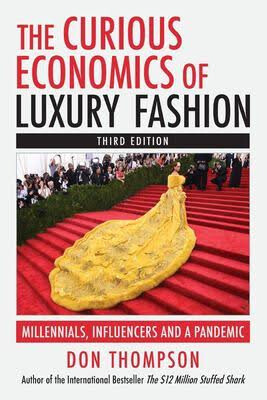
This book gives a very good overview of the fashion industry, especially the luxury fashion segment. The luxury fashion world is experiencing a massive change because of millennial and Gen-Z culture, increasing influence of social media, and of course the pandemic. Prior to 2020, that fashion world was making a slow and painful transition from being designer-driven to consumer-driven but pandemic has accelerated that transition.
Here are my notes –
WHAT IS THIS ‘LUXURY FASHION’?
-
Over two decades, high fashion went from an industry of family-run businesses to one where conglomerates LVMH, Kering and Richemont, and two independent brands, Hermès and Chanel, controlled 40 percent of the (as of 2022) $350 billion market for personal luxury goods.
-
After the 2020 pandemic, these five became even more dominant as independent luxury and premium players fell by the wayside.
-
Fashion is in most ways a fragmented industry. There are many product categories, many customer groups, the three conglomerates but also several thousand small fashion houses.
-
There are two very different levels of high-end fashion labels, usually referred to as luxury and premium. Below those two levels are accessible and fast fashion.
-
Luxury apparel may be haute couture—personally tailored and based on a runway design. Or it may be ready-to-wear, called ‘prêt-à-porter’.
-
Apparel is for a luxury house the ‘brand-defining core category’, but apparel produces little profit—because of the high cost of advertising and runway shows, and because so much inventory remains unsold at the end of a season.
-
Financial analysts consider too much dependence of a luxury label on apparel sales a drag on a house’s profitability and share value. For fashion conglomerates LVMH and Kering, apparel is only about 10% of sales—and less than that of profits. The money-spinners are their handbags, shoes, accessories and fragrances.
-
Luxury fashion, art, and religion are similar. Each is concerned with timelessness; each emphasizes a creator and a founding myth and legend. Each uses storytelling to maintain mystique. Each has symbols and icons recognized by followers. Each has its urban cathedrals, a museum or an elegant flagship store or art dealer.
-
Luxury advertising never mentions price or product attributes, and never uses superlatives or invites comparison with competitors.
-
The dilemma faced by luxury fashion labels is how to grow sales in a mature market without violating the perception of scarcity. Rolls Royce once released a press statement claiming that each year it produces only one more car than the year before.
-
Rolex sells three million watches each year. It represents luxury because the brand has managed to maintain its image of quality, exclusivity—and perceived scarcity.
-
Luxury brands invest to maintain control of the full supply chain, from the crocodile farm to store décor
ARNAULT AND INNOVATION
-
Arnault started his career is real state but switched to fashion after a cab driver in New York told him that Christian Dior is the president of France
-
LVMH’s is second only to Royal Dutch Shell as the most valuable firm in the European Union
-
Louis Vuitton is the largest luxury fashion brand in the world. It accounted for a quarter of LVMH’s sales and almost half its profit.
-
According to BrandZ rankings, LV is the most valuable luxury brand label, worth $47 billion. Chanel is the second most valuable luxury brand label at $37 billion, and Hermès Paris is third at $31 billion.
HERMÈS: TRADITION AND ARTISANSHIP
-
“The luxury industry is built on a paradox; the more desirable the brand becomes, the more it sells; the more it sells, the less desirable it becomes. As soon as a product sells too much, we discontinue it.”
-
Fashion writers regularly name Hermès as “the most admired company in luxury fashion.”
-
Hermès is also very profitable: the company’s 2021 sales were estimated at €8.4 billion ($9.6 billion), and the net profit €3.4 billion ($3.9 billion).
-
Hermès is the polar opposite from LVMH in its luxury fashion philosophy and adherence to tradition. The firm is not a conglomerate enterprise with a portfolio of firms and labels. It is a portfolio of products, offered under a single label.
-
The most cited example of company artisanship is the production process for a high-level Birkin or Kelly handbag. A single artisan performs all steps stamps their initials and the date inside the completed bag, as an artist might sign a painting or sculpture.
-
Birkin and Kelly handbags contribute 25 and 30 percent of Hermès sales and as much as half the houses’ profit
-
The long-held belief in the world of luxury fashion is that reliance on celebrities to promote products is a sign of potential brand weakness. Hermès follows the ‘no celebrities, no paid endorsements’ rule more than any other fashion house.
-
The waiting list for a high-end Birkin or Kelly is six to nine months.
PREMIUM FASHION
-
Premium labels typically sell for 40 to 60 percent the price level of luxury brands. They are occasionally discounted—but much less often than accessible brands.
-
As a group, premium fashion firms lose money.
-
In 2019 the top ten luxury or premium fashion companies sold more than the next 90—combined. Just 20 companies earned 90 percent of the profits in the luxury and premium fashion sectors.
ACCESSIBLE FASHION
-
The third fashion segment is known as the ‘accessible’. This does not fit easily into a discussion of high-end fashion.
-
Accessible labels are attractive to millennials, and their design and price points exert on the premium market.
FAST FASHION
-
There is a fourth segment, known as fast fashion. It is the largest by far, both in unit volume and dollar sales.
-
The fast fashion labels—think of Zara, H&M or Uniqlo—have expanded because of their design quality combined with value positioning—‘chic, not cheap’—and the millennial acceptance of mixing and matching fashion labels in one outfit.
-
In 2019 Zara had sales of $25 billion, H&M had $26 billion, and Uniqlo had $23 billion.
-
Zara and H&M in particular put time pressure on high-end labels. They can reproduce a well-reviewed runway fashion from a telecast or photographs and have those designs in stores well before the ready-to-wear arm of the fashion house that created the garment.
-
Fast-fashion firms force fashion designers at all levels work to a shorter fashion cycle and an accelerated manufacturing schedule.
HAUTE COUTURE AND THE RUNWAY
-
The clothes a designer sends out onto the runway are worthless unless they increase the sales of handbags, sunglasses and perfume.
-
There are only a “few hundred” clients in the world who buy direct from haute couture shows. They include Middle Eastern royalty and American professional women.
-
Haute couture roughly translates as ‘high dressmaking’ or ‘high sewing’. The term has roots in 19th century French fashion, when wealthy women had dresses with hand stitching and multiple fittings.
-
Prêt-à-porter (ready-to-wear), by comparison, refers to factory-made clothing sold in finished form and in standard sizes.
MILLENNIAL INFLUENCE
-
“What was not expected was the structural transformations in the market, the rise of millennials, which had, on average, represented around 30 percent of the market. Suddenly, within two to three years, it went from 30 to more than 50 percent” (François-Henri Pinault, CEO of Kering)
-
Millennials and Gen-Z, have become the most important segment of the fashion world—and the Chinese cohort are the largest and now the most important part of that demographic. The segment for represents ~65 percent of sales.
-
For generations, two things have marked a fashion brand as luxury: artisanship and exclusivity. Millennials are not very interested in those attributes.
-
They are also less impressed with the outward display of traditional, brand-based status. They seek fashion that reflects their identity and is an extension of themselves and their values. What motivates them is a sense of expression, seeking new experiences that match their lifestyle. Another difference from their parents is that they do not see status as a zero-sum game; for them to have more, it is not necessary for someone else to have less.
-
Millennials seek social and economic status in a different way than did their predecessors. Experiential purchases reinforced their status in the same way that high-end fashion or art did for previous generations.
-
Millennial values are at odds with many of the traditional practices of luxury fashion. Most millennials see runway shows, glossy print luxury goods advertising, seasonal collections, high prices, glittering flagship stores and high-markup department stores as either uncool or irrelevant.
-
The strangest example of millennial interests and values changing the world comes not from fashion but from Olympic sports. The 2020 the Summer Olympics—later postponed to 2021—added skateboarding to its medal competitions. The IOC is adding break dancing to the Paris summer games in 2024.
-
In 2021 Louis Vuitton Men’s offered a skate trunk and skateboard set. These were inspired by street boarders, but not intended for them; the set was priced at $58,000. Hermès, Celine, Gucci and Saint Laurent all now offer their own branded skate decks.
-
The practice of drip-feeding product in limited quantities began in Japan, and was adopted in the west by streetwear labels like Supreme. European luxury houses have embraced drops because they resonate with millennial consumers.
THE STREETWEAR REVOLUTION
-
“Fashion has flipped. People in power like Mark Zuckerberg wear jeans and people with less status wear suits.”
-
Streetwear had its origin in the 80s and 90s, first as a niche market built on skateboards and hip-hop. The core products were sneakers, unisex T-shirts and hoodies.
-
Streetwear has become a growth category for Louis Vuitton and other fashion labels, especially post pandemic
-
Streetwear promised LV and other luxury houses access to a millennial market, and to high margins. Balenciaga offered hoodies, T-shirts and sneakers. One of their best-selling lines is Triple S sneakers.
FASHION COOL AND THE TIPPING POINT
-
“Cool is the highest value in modern society, shaping consumption, politics and parenting” (Vanessa Brown)
-
Fashion commentators sometimes use the Italian term sprezzatura, meaning ‘studied ease’.
-
Marlon Brando’s appearance in the 1953 movie The Wild One made the T-shirt acceptable dress in many settings. President John F. Kennedy went hatless in 1961 to every event, formal and not, which signaled to a generation of American males that hats were passé.
HANDBAGS TO IMPRESS
-
For decades, handbags have driven profit for luxury fashion. In 2019 they accounted for more than a quarter of the sales of the firms in high fashion.
-
For LV, handbags comprise 75 percent of revenue. At Prada it is 45, at Gucci 40, at Hermès 33.
-
List prices average twelve times manufacturing cost at the luxury level, four to six times at the premium, and a bit less at the accessible level.
SNEAKER CULTURE
-
Luxury sneakers are very profitable. Made with better-quality suede or leather than regular sneakers, the most expensive designer models may cost $40 to $50 to produce, but retail at six to ten times that amount.
-
In 2020, Forbes reported that Kanye was earning $160 million a year pre-tax from YEEZY royalties (more than what Michael Jordan earned in royalties from Nike – $130 million)
CHINA
-
Since 2008, China has moved from being a niche market to being the world’s second largest consumer of luxury goods, including fashion.
-
European brands have historically cultivated the idea that they represent the ultimate in tradition, prestige and luxury. This makes them more sought after than American brands.
-
Online accounts for a greater proportion of total retail sales—and fashion sales—in China than in any other country.
-
Chinese concept of ‘Mianzi’—the importance of maintaining self-esteem, reputation, and social status.
-
The Communist Party flip-flops in its tolerance for luxury. In 2012 the city government in Beijing banned the advertising of luxury goods on billboards and in print ads.
ESG
-
“Sustainability is the new definition of quality. It is inherent to luxury. That is the new normal.”
-
In 2020 the US banned cotton imports from the Xinjiang Production and Construction Corp., a paramilitary organization that is one of China’s largest cotton producers. The ban came over the alleged use of forced Uyghur labor. The Xinjiang area accounts for 20 percent of global cotton supply.
-
The oil industry is the most polluting in the world. The fashion industry and the textile production for it, is second.
-
Luxury fashion house often burn whatever goes unsold. Burberry’s 2017/18 annual report stated that the “cost of finished goods physically destroyed in the year was $37 million to maintain brand value.”
-
In 2020 when Chanel issued a $700 million sustainability-linked bond on the Luxembourg Stock Exchange. The bonds carry a slightly below-market interest rate, but offer holders a large penalty payment if the issuer does not meet stated green goals during the life of the bond
Cambridge Analytica, Trump, Fashion
-
Cambridge Analytica gained fame and notoriety by harvesting the data of millions of individuals and used it in the 2016 Trump presidential campaign.
-
A significant part of their research focused on fashion, and on how an individual’s stylistic and aesthetic preferences predicted how susceptible they were to right-wing political ideas.
-
Those with preferences for brands such as Kenzo were not targeted (the Kenzo label was one of the first to use multicultural runway models)
-
Similarly, those who liked Alexander McQueen, Louis Vuitton and Stella McCartney were assumed as being strong Democratic supporters. Their Facebook ads did not target users who preferred these brands.
-
“We exploited the cultural narratives that the fashion and culture industry put out”
-
Cambridge Analytica’s research director moved on to become the research director at H&M
FARFETCH
-
Farfetch is an e-commerce company focused on luxury fashion.
-
It’s 2018 IPO valued the company at $5 billion. At that number, it was one of the most highly valued fashion companies in the world.
-
The market placed an unexpectedly high valuation on the potential for Farfetch’s strategy.
-
Its valuation of five times previous-year sales should be compared to a typical fashion retailer that would go public (pre-pandemic) with an IPO at 1.2 times sales.
-
Clearly, Farfetch didn’t live up to its hype
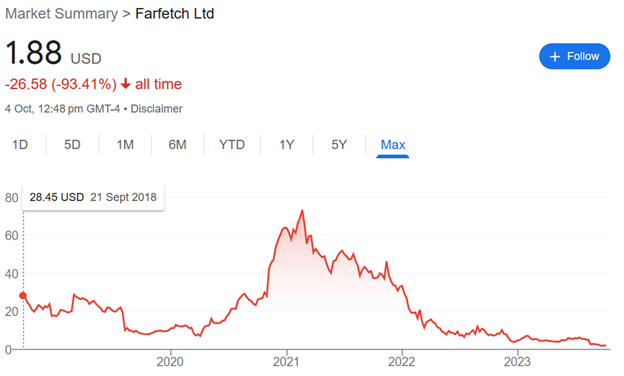
DEATH BY AMAZON AND AI
-
“Amazon acts as kryptonite for conventional retailers serving millennials; it just has to get close enough to their product mix to have its effect felt.”
-
Amazon is the largest private label fashion provider, and the great looming threat to existing premium brands—particularly after brand failures that resulted from the 2020.
-
70 percent of the ‘word searches’ done on Amazon are generic: ‘running shoes’ or ‘party dress’. The generic query allows Amazon to offer its private-label products on the first screen.
-
Bespoke Investment Group has been tracking 54 retail stocks since 2012 known as their ‘Death by Amazon’ share index. Between February 2012 and October 2020, Amazon’s value rose 640 percent, while the S&P index rose 105 percent. The Death by Amazon index grew just 41 percent.
LUXURY FASHION AFTER COVID-19
-
Pre-pandemic luxury brands had 5 to 15 percent of their worldwide sales in airport boutiques, a large portion of these to Chinese tourists.
-
Luxury houses responded quite differently to the pandemic – they continuously increased the prices from May 2020 onwards. Whereas the premium brands were lowering list prices or discounting.
-
Resale of previously owned fashion flourished during the pandemic. Bain & Co. estimated the 2021 world’s luxury resale market at €33 billion ($38 billion). A few major luxury brands that had previously shunned the second-hand market, now embraced it both to offload excess inventory and to offer lower entry price points.
-
After most tragic periods, from the Black Death to the Second World War, there followed a period of exuberant fashion
PPFAS Financial Opportunities Forum (05-10-2023)
Thanks for the post and discussions. I humbly want to share my experiences with different types of funds.If one takes the timeframe of 5 years, in most of the cases the small cap funds beat flexi cap and large cap with 2-3 percent at least. Only exceptions can be a particular fund going very bad or performing beyond expectations. I can suggest that the best way is stay invest in small cap funds (not in one fund),so that severe underperformance of one fund gets averaged out.Now market cycles have become smaller, so it doesn’t take more than five years.Even for PPFA, they suggest 7-8 years duration for good performance.Just to add a point,Motilal Oswal micro cap index fund (500-750) brochure mentions that on longer time scale micro cap index backtesting shows the return of 25%,although, it can be very volatile in the short run.As it is the single fund in that category we do not have other funds to compare.I hope honourable members will share their opinion in this regard.
Multi-Disciplinary Reading – Book Reviews (05-10-2023)
loved the summary, will definitely read it.
Hitesh portfolio (05-10-2023)
Hitesh Sir
As a retail investor, Is it possible to identify Next sector in line at early stage ?
Q1. Typically, by which time frame/by which means do retail investors become aware of a promising sector ?
Q2. Which could be the Big funds/ Big guys to follow, to learn about the sector in the favour ?
If i find recently launched certain quant fund investing in telecom hardware, telecom software, telecom infrastructure, Can we say telecom could be the next sector in a rotation ?
Warm Regards
PPFAS Financial Opportunities Forum (05-10-2023)
That is true! But the problem is most of us haven’t seen the volatility and downturn in smallcaps. They may be in downturn or sideways for 5-6 years which will test the patience. I haven’t seen anyone who investing in funds staying that long without redeeming.
So instead of having everything in smallcaps it’s better have optimum allocation across caps.




